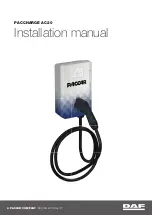
7
FIGURE 10
USE RIVETS OF CORRECT LENGTH AS SHOWN
CORRECT
8. Install the anchor pin into the spider. Center the anchor
pin in the spider so it protrudes equally from each side.
9. Install new brake shoe retaining springs. Engage hook
ends of the two springs into each of the tabs of the two
brake shoes.
10. Place the top shoe onto the spider by engaging the
open slots on the end with the retaining springs onto
the anchor pin. Place opposite end of the shoe against
the S-cam. Swing the opposite shoe, with springs
attached, back until slots in the shoe engage the anchor
pin, then swing shoe toward the S-cam. Spring tension
will hold the shoes in this position.
11. Place the hook of the brake shoe return spring onto the
return spring pins on one shoe. Hold shoes against the
S-cam and connect the other hook of the brake shoe
return spring over the return spring pin of the other shoe.
12. Insert a sturdy bar between the end of one of the brake
shoes and the spider housing at the S-cam end of the
shoe. Pry down until the brake shoe roller and pin can
be installed between the S-cam and the slots in the end
of the brake shoe. Repeat the same procedure on the
other shoe.
13. Adjust the slack adjuster until the yoke pin can be
installed through the proper hole in the arm. Install a
new cotter pin to retain. Make sure the cam rollers are
in the lowest position on the cam.
14. Lubricate the cam shaft bushings by filling the cam shaft
tube with chassis lube through the zerk fitting provided.
Fill until grease is forced out in the area of the slack
adjuster. Grease should not appear at the cam head
end. If it does, the new seal has not been properly
installed, or the old seals should be replaced.
15. Reinstall brake drums and wheels. Torque and adjust to
manufacturer’s specifications.
16. Spin the wheel slowly and adjust the slack adjuster until
wheel will no longer turn. Back off slack adjuster just
enough for wheel to spin freely. Be sure to adjust brakes
equally on each axle.
17. Apply and release brakes and observe slack adjusters.
Both slacks on each axle should respond rapidly and in
unison during application and release.
18. Drive vehicle at a low speed in a safe area and check for
brake effectiveness prior to putting back into service.
RELINE PROCEDURE
When removing rivets from the brake shoes, be careful to
avoid doing any damage to the holes in the shoe. Do not
use a chisel to shear them off as the force will elongate the
rivet holes. Neglecting any elongated holes may result in a
loose lining installation. If holes are burred, they should be
filed down flush with the shoe table.
Rust often develops on the surface of the shoe table under
the brake lining or blocks. In addition, scale may form from
salt on the highways, or tar and oil may find their way into
the brake assembly. During every reline job, shoe tables
should be thoroughly cleaned. The best procedure is to steam
clean the entire shoe or put it in a degreaser.
After cleaning the shoe, the shoe table should be scraped
clean of rust and scale. Any burrs or nicks should be filed
smooth. At the same time, the entire shoe should be
examined to see whether it is worn or bent.
The shoe should be either reconditioned or discarded. It is
also necessary to check for flat spots on the shoe that can
be caused by cleaning away the rust from the area that
was under the block previously. This can cause a mismatch
of shoe and lining arcs. After the shoe is cleaned and
inspected, it should be given a coating of rust preventative
paint. Such treatment of a new, unpainted shoe is also
suggested to prevent the initial rusting problem. Before
riveting, clamp the blocks tightly to the shoe, placing the
clamps close to the rivet holes. Be sure the holes in the
blocks and the shoes are exactly matched.
Never shim the brake linings as this will only cause
problems. Brake noise may result because of cracked
and loose lining since a tight installation is not possible.
The inside surface of the lining is the correct arc to
match the shoe table, and the rivet holes in the linings
will only line up with holes in the shoes when they are
in direct contact.
The sequence of riveting should be such that the center of
the block is attached first and then the ends.
TOO LONG
TOO SHORT
USE ONLY
#10-10 RIVETS
FIGURE 11
ROLL SET EXPANDS RIVET INTO
HOLE BEFORE UPSETTING.
WHEN RIVETING BRAKE LINING
USE ROLL SET
NOT STAR SET
START SET SPLITS TUBE AND
RIVET DOES NOT FILL HOLE






























